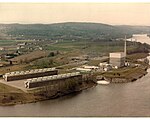Pisgah State Park
1967 establishments in New HampshireAC with 0 elementsChesterfield, New HampshireHinsdale, New HampshireOld-growth forests ... and 5 more
Parks in Cheshire County, New HampshireProtected areas established in 1967State parks of New HampshireState parks of the AppalachiansWinchester, New Hampshire
Pisgah State Park is a 13,300-acre (5,400 ha) public recreation area located in the Cheshire County towns of Winchester, Chesterfield and Hinsdale in New Hampshire. It is the largest state park in New Hampshire and contains a complete watershed north of the Ashuelot River, seven ponds, four highland ridges, numerous wetlands, and a 20-acre (8 ha) parcel of old-growth forest.
Excerpt from the Wikipedia article Pisgah State Park (License: CC BY-SA 3.0, Authors).Pisgah State Park
Reservoir Road,
Geographical coordinates (GPS) Address Nearby Places Show on map
Geographical coordinates (GPS)
| Latitude | Longitude |
|---|---|
| N 42.840277777778 ° | E -72.453611111111 ° |
Address
Reservoir Road
Reservoir Road
New Hampshire, United States
Open on Google Maps










